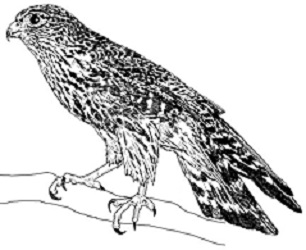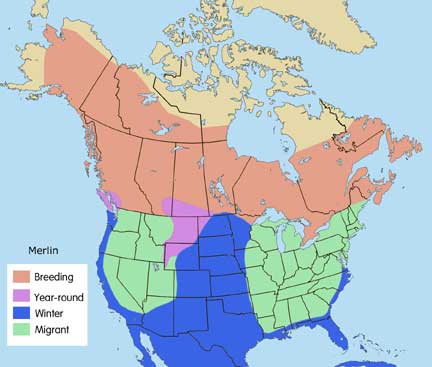
Scientific Name: Falco columbarius
Slightly larger than the American Kestrel, the Merlin is much more aggressive in behavior and more powerful in flight than its smaller falcon cousin. Females are larger, as with most birds of prey. Plumage differs between the sexes: adult males are gray-blue above, females are dark brown. Under parts are a pale rufous-red, with dark brown streaks and spots. Legs are yellow; the wings are short, pointed, and angular; the tail is dark with many thin whitish bands; the head has a dark crown, and a much fainter mustache mark than seen on other falcons. In flight, the Merlin can be distinguished from the American Kestrel by its darker underparts and longer, broader wing shape; the barred tail of the Merlin distinguishes it in flight from its larger falcon relatives, the Prairie and Peregrine Falcons. Merlins tend to fly rapidly in a direct line from one spot to another with short, fast, continuous wing beats. These feisty birds will aggressively harass other raptors who come into their territory.
Male
Length: 9 – 11″
Wingspan: 21 – 23″
Weight: 4.5 – 6.6 oz.
Female
Length: 11 -1 2″
Wingspan: 24 – 27″
Weight: 6.4 – 8.3 oz.
State and federally protected.
Prefer edge environments with scattered trees for perches and open terrain for hunting birds and insects on the wing. Habitats vary regionally, from mixed grassland and deciduous trees, to coniferous forests with open meadows or burns – wherever enough perches and a good food supply exist.
Birds form the majority of the diet. This falcon catches birds in flight with bursts of speed and rapid maneuvers. Usually hunts from a perch, taking off after spotting a potential meal, often flying low and in direct pursuit of prey. Also eats rodents, lizards, snakes, and insects – especially dragonflies.
This falcon is usually quiet. When alarmed, will give a strident, rapidly accelerating series of twitwitwitwitititititi, rising and falling.
Appropriates the nests of other species, or nests in tree hollows in areas where there are scattered trees or open woodland. Will also nest on bare cliff ledges, or on the ground in a scraped-out depression.
Collisions with vehicles.

This falcon is circumboreal in worldwide distribution. One or another of the three subgroups of Merlin found in North America breed from Canada and Alaska south into western mountain regions of the US, and winter throughout most of the central and southern part of the country, down into Mexico.
Special Thanks for range maps:
Dan Gleason
BGleason Design & Illustration
Commercial & Scientific Illustration, Graphic Design
CraneDance Communications
Book Production/Design

